Despite its growing popularity, the general public still has a lot to learn about marijuana. For example, few understand the chemical reasons why cannabis has to be heated – or decarboxylated – before consumption.
Let’s just say that if you were to consume a bag of raw weed, the effects would be very minimal. Decarboxylation converts the major phytocannabinoids in cannabis (THC and CBD) into active molecular forms that can influence our bodies’ neurotransmitters. In fact, without decarboxylation, marijuana would possess few – if any – of its medical and recreational properties.
Decarboxylation: A Requisite Chemical Reaction for Cannabis Edibles, Oils, and More
Heating cannabis activates the compounds contained within it. It turns acidic compounds like tetrahydrocannabinolic acid (THCA) into THC, along with a variety of other cannabinoids.
If you decide to make edibles with marijuana, the flowers need to be decarboxylated first. If you fail to decarb your weed, you’re doing little more than adding raw plant matter. As nutritious as raw cannabis is, it does little in terms of producing therapeutic benefits.
Raw Cannabis vs. Decarboxylated Cannabis
Raw cannabis is plant matter that has not been dried or cured. Once cured, a small amount of decarboxylation occurs. The rest takes place when the plant material is heated – or combusted – to temperatures above 200 degrees Fahrenheit.
However, marijuana still has beneficial uses in its raw, uncured form. Before curing and decarboxylation, THC and CBD – the two most active cannabis compounds – exist as acids (THC-A and CBD-A). These acids possess anti-inflammatory effects, similar to vitamins and minerals found in other plant-based foods.
DID YOU KNOW? Eating raw cannabis has many nutritional health benefits?
If you consume raw cannabis, use either the fan leaves or flowers that have been freshly picked. Raw marijuana can be stored in your refrigerator just as long as other greens like kale or spinach. However, it is essential to monitor your raw cannabis because it is prone to wilting and mold. This is particularly true for densely-packed flowers that contain a high moisture content.
If left undisturbed, the active compounds in cannabis will decarboxylate over time. However, total decarboxylation of THC-A and CBD-A in raw plant material would take years. When exposed to heat, the compounds decarboxylate instantaneously.
What Is Decarboxylation?
Even though raw (carboxylated) cannabis possesses nutritional benefits, it is entirely non-intoxicating. In other words, it will not produce a high. To get the full effects of marijuana, it has to be heated – or decarboxylated.
As we mentioned above, the process of drying and curing can release a small number of psychoactive compounds. However, this pales in comparison to the number of cannabinoids released during decarboxylation.
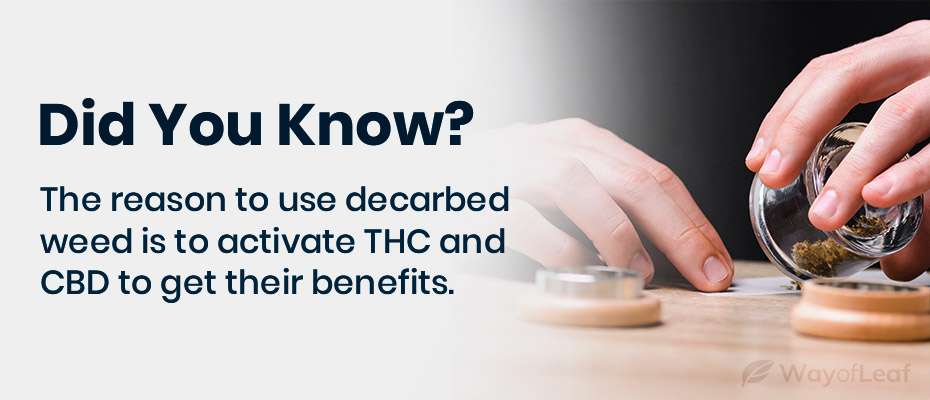
The term decarboxylation refers to the chemical reaction that removes a carboxyl (COOH) group from THC-A and CBD-A. Carbon dioxide is released as a by-product of this reaction. To decarboxylate marijuana, all you have to do is apply heat. But how much heat is necessary? Or in other words, at what temperature does marijuana decarboxylate?
We will answer this question later in the article. First, let’s take a look at some of the other advantages of decarboxylation. That is apart from the fact that it produces chemically-active forms of phytocannabinoids.
Advantages of Decarboxylation
One of the most common mistakes people make when making edibles from marijuana is failing to decarb their cannabis. Unless you’ll be baking your edibles (pot brownies, cookies, etc.) before consumption, it is necessary to use an oven to heat the plant material and release the activated THC and CBD.
Incidentally, when you decarb weed for edibles, you also reduce the risk of botulism. When you don’t go through the process correctly, botulinum bacteria can quickly grow in things like cannabutter and canna-oil.
Of course, every time you light up a joint or vaporize your weed, you are automatically decarbing it. In the absence of its carboxyl group, tetrahydrocannabinol (THC) can bind to the body’s cell receptors. But what about cannabidiol – does CBD need to be decarboxylated?
Why You Need to Decarboxylate CBD Strains
You may think that CBD decarboxylation is unnecessary. After all, why would you need to decarb a strain that’s already non-intoxicating?
In reality, the same decarboxylation rules apply to CBD as they do to THC. Because raw cannabis contains the acid form of CBD (CBD-A), CBD strains must be heated to release their active properties. Like THC-A, CBD-A has its health properties. It’s believed that if you consume CBD-A, your body will metabolize it and break it down into CBD on its own.
Decarboxylation of CBD increases its bioavailability, making more of it available to the body’s cells.
However, cells need to work harder to break down CBD’s carboxyl component. Moreover, much of the active compound is lost as heat during the exothermic reaction. In other words, having your body decarb CBD on its own would be extremely inefficient.
Exposing the plant material to sufficient heat decarboxylates CBD instantaneously, as described above. Products like CBD oils or CBD gummies, however, have already been decarboxylated. This is why you can consume them in their natural state, without having to heat them.
How to Decarboxylate Weed
Aside from smoking or vaping, there are many ways to decarboxylate weed and gain its therapeutic and recreational effects. We’re going to show you the most basic one. You’ll need the following equipment:
- An oven
- A baking sheet
- Parchment paper
- Cannabis flower (trim, nugs, kief, etc.)
If you elect to use nugs, grind them coarsely before following these steps. In the following example, we used 40 grams of flower to produce coconut canna-oil.
Step 1: Preheat the oven:
Set the oven to 235˚ Fahrenheit (120˚ Celsius). Place the parchment paper on the baking sheet, and spread your marijuana flower across it. Make sure to break up larger pieces with your hands if necessary.
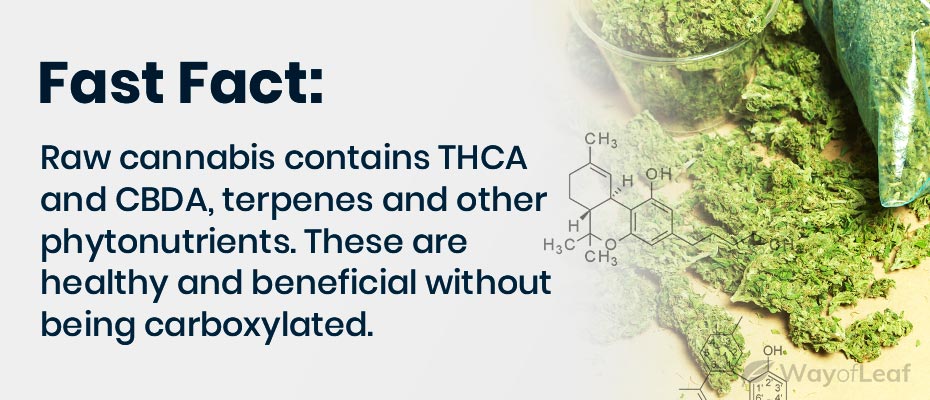
Step 2: Bake for approximately 40 minutes:
This should be a sufficient amount of time for well-dried weed. However, please note that if you’re using fresher marijuana with more moisture, it could take up to 90 minutes.
Some users invest in a hygrometer to check the level of moisture in their herb. It is easy to use; place the weed in a closed container with the hygrometer. After the weed is dry enough, leave it to completely cool. However, you don’t necessarily need a hydrometer to do the job correctly.
Step 3: Remove and let cool:
After the decarboxylation process is complete, remove the baking sheet from the oven and let it cool down. Now the majority of THC-A and CBD-A should be converted into THC and CBD.
Decarboxylation Temperature for THC and CBD
If you ask twenty different cannabis users what temperature they decarb their weed at, you’ll likely get twenty different answers. We can tell you that the lower the decarboxylation temperature, the longer the chemical process takes. But few people realize that if decarboxylation temperatures are too high for too long, you risk ruining the herb’s active ingredients.
There is a dispute over the exact decarboxylation temperature of CBD. According to studies, it appears to be approximately 230 degrees Fahrenheit (110 degrees Celsius).
As for the timeframe, neither THC nor CBD will decarboxylate instantaneously at their precise decarb temperatures. A more extended period – typically between 40 and 60 minutes – is required for the COOH group to break down into water and carbon dioxide.
Also, be advised that the boiling points of cannabinoids, terpenes, and flavonoids are much different than their decarboxylation points. Boiling points for these compounds have been much more thoroughly studied than their decarb temperatures:
Cannabinoids
- CBC: 428˚F /220˚C
- THC: 314˚F/157˚C
- CBN: 365˚F/185˚C
- THCV: 428˚F/220˚C
Terpenes
- Myrcene: 330-334˚F / 165-168˚C
- Limonene: 150˚F/177˚C
- Linalool: 388˚F/198˚C
- Alpha-pinene: 312˚F/156˚C
Flavonoids and Phytosterols
- Beta-Sitosterol: 273˚F/134˚C
- Cannflavin A: 359˚F/182˚C
- Apigenin: 352˚F/178˚C
- Quercetin: 482˚F/250˚C
It is advisable to keep your decarboxylation temperatures on the low side to preserve terpenes. Some compounds are volatile and evaporate at higher temperatures. The result is foul odors and an unpleasant taste. To preserve the terpenes, try and keep the temperature in the 200-300˚F range.
Now that we know the key to faster decarboxylation is greater heat (within reason), it should be a straightforward process. Unfortunately, it isn’t quite as easy as that. The existence of another mechanism means we have to control decarboxylation temperatures very carefully.
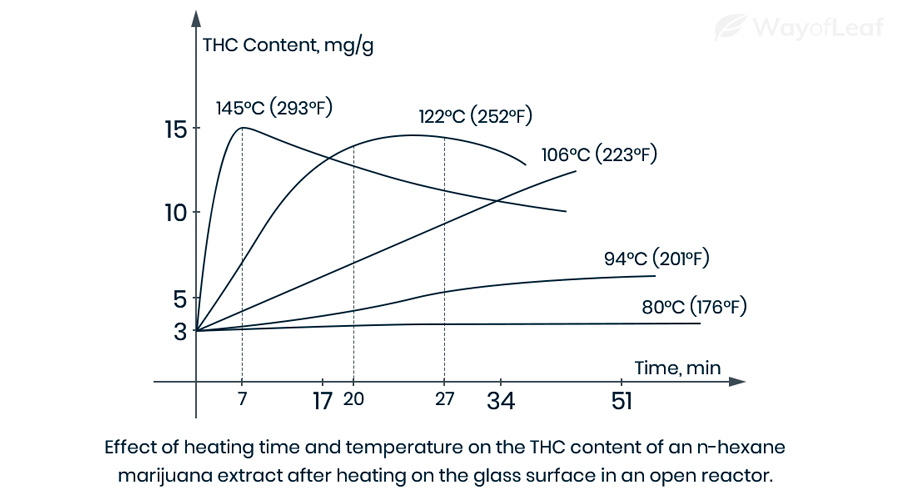
When we heat cannabis and turn THC-A into THC or CBD-A into CBD, we convert THC to CBN faster. Once we reach 70% decarb, THC gets converted into CBN faster than the conversion of THCA into THC. In other words, when we go beyond 70% decarboxylation, THC levels start to fall off quickly. See the above chart for reference.
As helpful as graphs are, there is always an issue with the interpretation of data. For instance, the graph above relates to marijuana extract data. The temperatures used for kief, bud, or trim would be different. The graph was created in 1990 and involved decarbing a hexane extract in an open container on a hot plate. With modern equipment, it is possible to reach a 100% decarb without damaging your THC content.
Kief
| Before Decarb | 30 Min Decarb | 60 Min Decarb | Compound |
|---|---|---|---|
| THCA | 24.5% | 2.6% | 0.1% |
| THC | 3.8% | 25.4% | 25.5% |
| CBDA | 0.6% | 0.3% | 0.3% |
| CBD | 0% | 1% | 0.1% |
| CBN | 0.4% | 1% | 1.4% |
| Moisture | 0% | 0% | 0% |
| Total Cannabinoids | 29.3% | 30.3% | 27.4% |
Cannabis Trim
| Compound | Before Decarb | 30 Min Decarb | 60 Min Decarb |
|---|---|---|---|
| THCA | 6.5% | 2.9% | 0.2% |
| THC | 0.6% | 4.8% | 6.9% |
| CBDA | 0.2% | 0.2% | 0.1% |
| CBD | 0% | 0% | 0.1% |
| CBN | 0% | 0% | 0% |
| Moisture | 3.4% | 4.5% | 0% |
| Total Cannabinoids | 7.3% | 7.9% | 7.3% |
Marijuana Growers HQ’s efforts went some way towards solving the mystery of the best decarbing temperature. In 2012, they tested cannabis trim and kief at 240 degrees for 30 and 60 minutes. The above table outlines the results.
They discovered that the vapor point of all significant terpenes, flavonoids, and cannabinoids was right around 246.2 degrees during their research. As consumer-grade ovens are not that reliable when reading temperatures, they played it safe by staying a few degrees below at 240 degrees.
According to the results, 30 minutes was not long enough to completely decarb the trim or the kief. The latter had reached 90%, but the former only managed 60%. Both were very close to 100% after an hour.
Decarboxylation Methods Investigated
Most assume that the oven is the best way to decarb, but is this really the case? Bear in mind that most ovens will fluctuate by 10 degrees in either direction. When using the oven in the 250-400-degree range in particular, if the heat is 10-15 degrees more than what you’ve set, the result could mean the loss of essential compounds.
DID YOU KNOW? You could lose up to 33% of your THC via oven decarboxylation.
The crockpot/water bath method is a popular one because water boils at a very consistent temperature of 212 degrees (depending on altitude). While the max temp will preserve all compounds, the problem with this method is it’s impossible to achieve full decarboxylation.
This is because decarboxylation is not a linear process, as the last part of the THC-A to THC conversion process takes longer. When you use boiling water, the weed is exposed to heat for too long, causing degradation.
A product on the market called “Nova” claims to decarb cannabinoids with 100% efficiency. It provides lab tests to back up this claim. Therefore, it may be worth checking out if you’re dedicated to keeping the potency of your cannabis intact.
The other issue with decarb charts or graphs is a lack of knowledge of the precise starting point of the decarb process. In other words, the times and temperature figures shown are always the averages. Remember, you can’t place dry material in an oven and expect it to remain at that exact level for the duration of the decarbing process.
How to Decarboxylate Kief
Kief is the name given to the crystallized structures that stick to the surface of pure cannabis. It is essentially cannabis dust that acts as a defense mechanism to keep pests away. Kief is a popular by-product of cannabis consumption used for edible creation.
If you decide to try kief decarboxylation, grind the cannabis into flakes and sift the kief away from the plant parts.
Kief tends to decarb faster than bud, meaning you can afford to employ a lower temperature. Once you have spread it over the baking sheet, follow the steps mentioned above. Place the kief on a parchment sheet, and put it in the oven between 240-300˚F (115 – 150˚C). It should be fully decarboxylated after 45-60 minutes.
Final Thoughts on Decarboxylation
Decarboxylation is one of the least understood aspects of marijuana parlance. To fully benefit from cannabis, most of the active components first need to be decarboxylated. THC-A must be transformed into THC, CBD-A into CBD, and so on.
When you combust cannabis or use a vaporizer, the process of decarboxylation occurs instantly. However, those who prepare edibles have to go through a time-consuming decarb process to ensure their products are “molecularly active.”
Although there is some merit to consuming raw cannabis, it offers few therapeutic (or recreational) benefits compared to the decarbed version.
Want to learn more? Decarboxylation is extremely important, but so is knowing how to dry and cure your harvested marijuana flower. Learn how to do it properly in our Complete Guide to Drying and Curing Cannabis Buds.

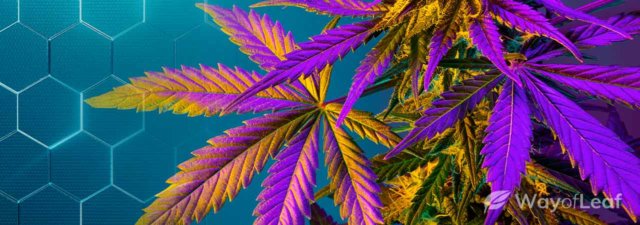

![Bisabolol Cannabis Terpene [All You Need to Know]](https://wayofleaf.com/wp-content/uploads/2020/11/wol-banner-bisabolol-cannabis-terpene-640x225.jpg)
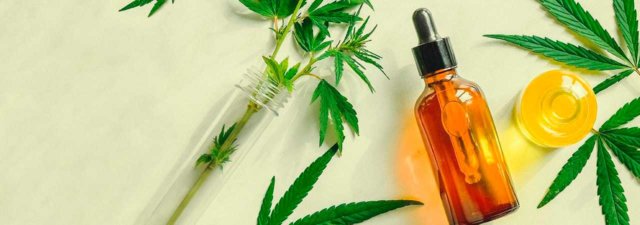
![Why Does Marijuana Make Your Heart Race? [The Science Behind]](https://wayofleaf.com/wp-content/uploads/2019/10/wol_why-does-marijuana-make-your-heart-race-640x225.jpg)
![Do Terpenes Get You High? [Understand the Facts!]](https://wayofleaf.com/wp-content/uploads/2019/08/mj_do_terpenes_get_you_high_1920-min-640x225.jpg)




![HHC vs. Delta 8 [Explained]](https://wayofleaf.com/wp-content/uploads/2023/01/wol-banner-hhc-vs-delta-8-640x225.jpg)
